The Apple Thunderbolt Display Review
by Anand Lal Shimpi on September 23, 2011 2:56 AM EST- Posted in
- Displays
- Mac
- Apple
- Thunderbolt
- Thunderbolt Display
Dissection
If you haven't gathered by now, the Thunderbolt Display isn't a regular monitor - it has a lot of components inside that you'd typically only find in a full fledged computer. Being the curious cat I am, I wanted to see inside. Apple isn't too fond of us poking around inside their review samples, but luckily the Crabtree Valley Mall Apple Store just got Thunderbolt Displays in so I hopped in the practical-wagon and grabbed one in the name of science.
Apple has an incredible fascination with using magnets in its designs. What it enables are some pretty neat enclosures, particularly on its displays. The glass front of the Thunderbolt Display is actually identical to what's used on the 27-inch LED Cinema Display and iMac. The glass is held to the chassis via several very strong magnets. To remove the glass you'll need to use suction cups:
Behind the glass front is the actual LCD panel itself. The LCD and backlight are enclosed in a single unit. What we're interested in is behind the LCD however. Unplug a few cables and remove a grounding screw and the LCD unit is easily cast aside. Behind it are two discrete PCBs:
The PCB on the left is the monitor's power supply. Looking at another half-wave rectifier isn't on my to-do list this time, so we turn our attention to the right PCB. This is the board that handles all of the IO on the Thunderbolt Display. All of the screws we've removed thus far just need a T9/T10 torx bit.
The Thunderbolt Display's motherboard is full of controllers driving all of the rear facing IO ports. Contrary to what we originally posted, I now believe this is the same Light Ridge controller we've seen on other Macs (not the MacBook Air):
The external Thunderbolt cable actually continues inside the display and ends up at an internal Thunderbolt port. The cable terminates at the port and then is routed via traces on the PCB to the Eagle Ridge chip:
The other controllers are sprinkled around the PCB, although there's enough space between all of them to make routing nice and easy. The beauty of designing PCBs for monitors like this is you have tons of room to work with.
Pericom provides a PCIe x1 to 4-USB-port adapter on the board:
The internal speakers are driven by a combination of an ST-NXP 0161ET USB audio controller and an Analog Devices ADAV4601 audio processor. The ST-NXP controller sits on an internal USB interface, while the ADAV4601 dangles off of it.
That wraps it up for the front of the PCB. Around back there's a collection of stereo amps as well as the GigE (Broadcom BCM57761) and FW800 (LSI L-FW643E-2) controllers.
There's nothing immediately apparent in the PCB design that would point to the cause of the issue we saw with the Promise Pegasus interfering with the Thunderbolt Display's USB audio controller. The root cause must be exclusive to the Pegasus.








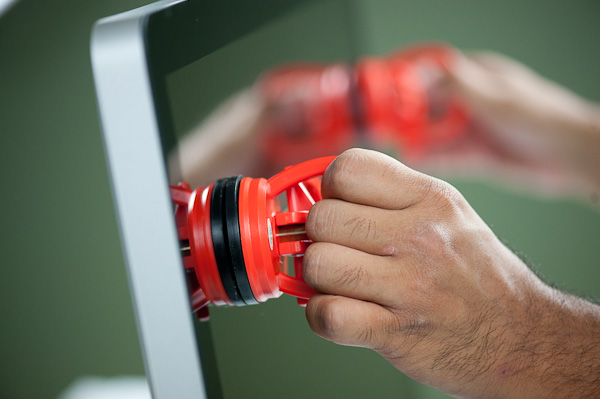
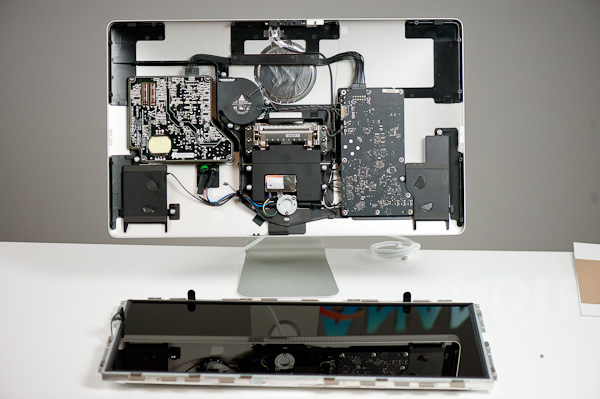
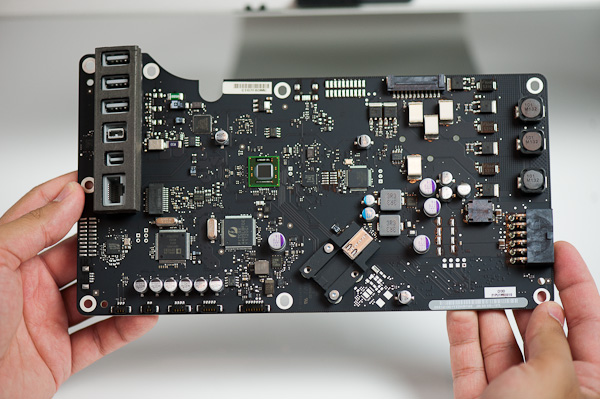
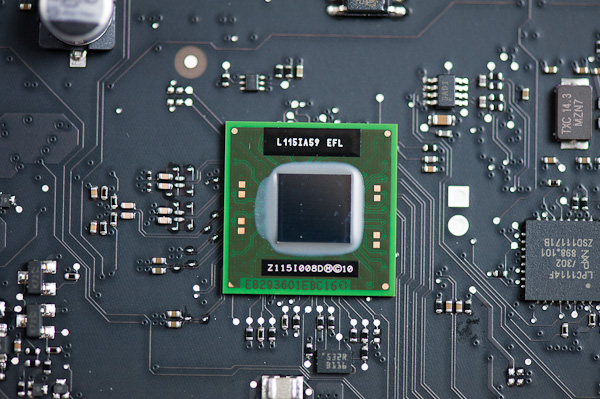
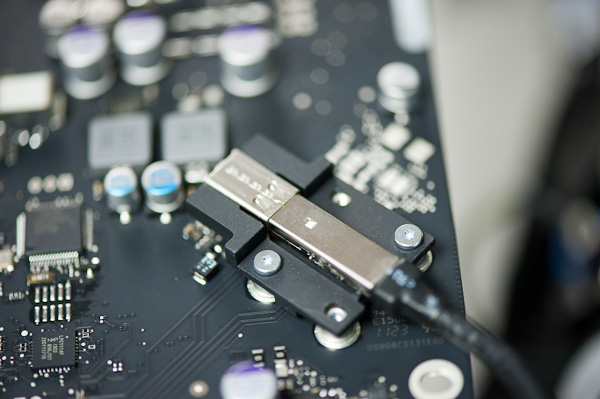
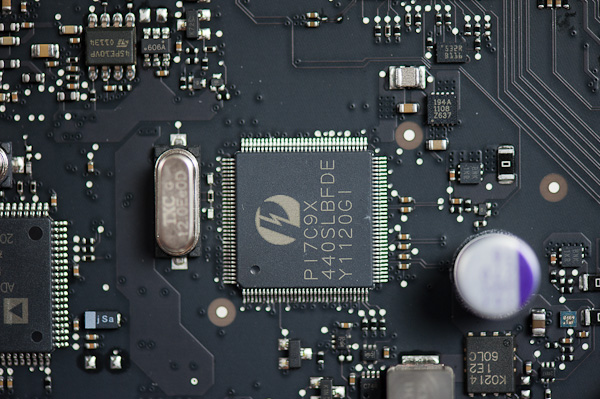
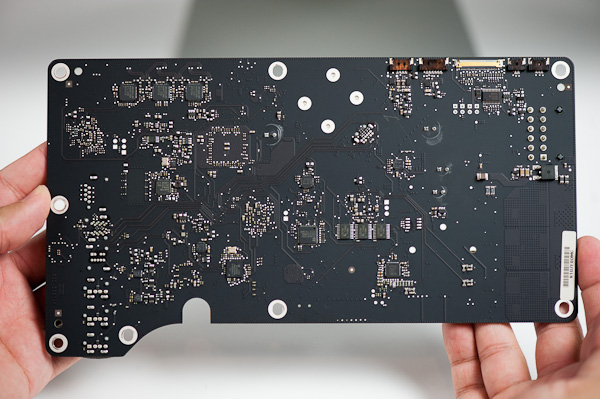
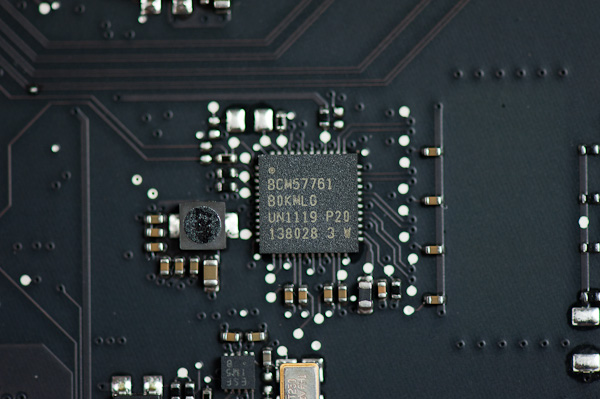








275 Comments
View All Comments
PWL_Steve - Friday, September 23, 2011 - link
I'm planning on buying an MBA soon so really appreciated the review of the display. For just about the same price, I could purchase the smaller iMac. Would it work the same way with a MBA as the Thunderbolt display would? Buying the IMac would allow my wife to have her own system and I would still be able to occasionally use it as a large display.Thanks
JasperJanssen - Saturday, September 24, 2011 - link
No, the iMac in target display mode *only* provides a display. No power, no USB, no camera, and definitely no ethernet/firewire. I'm not sure about audio -- displayport Target Display Mode included audio as well as video, but the thunderbolt iMac is different enough that I don't know about that one.But as long as the display is all you want, sure, that works. Do keep in mind of course that the smaller iMac is a much smaller (cheaper) display.
tanjo - Friday, September 23, 2011 - link
Apple, the biggest advocate of (almost)everything-in-one. Is it hard to separate the Thunderbolt to the display? If you find the Thunderbolt lacking and need to upgrade, you have to replace the Thunderbolt Display instead of just the Thunderbolt controller - a waste of a perfectly good display. How about making the Thunderbolt "box" dock at the back of the display? It'd still look clean.mcnabney - Friday, September 23, 2011 - link
Like maybe a VESA-compliant box that attaches to the back of any monitor?The lack of logic astounds me.
Oh, no, the iPeople couldn't handle the ugliness of a sleek box attaching to the BACK of their sleek display.
/aren't we in a recession?
slashbinslashbash - Friday, September 23, 2011 - link
No, there's no need to replace the Thunderbolt Display if something better comes out in the future. The beauty of Thunderbolt is that it is chainable, and the Thunderbolt Display has a chainable Thunderbolt jack. You can add an extra box in between the laptop and the Thunderbolt Display, or you can add an extra box after the Thunderbolt Display.Need USB3? I'm sure somebody will come out with a little box with a USB3 controller inside and a Thunderbolt interface. Your use of the Thunderbolt Display does not preclude your additional use of such a USB3 device: just plug it in to the Thunderbolt Display. Need an external GPU? Hook up the MBA to the external GPU Thunderbolt box, and then hook up that box to the Thunderbolt Display. Voila.
You still get 100% use of the stuff built in to the Thunderbolt Display (USB2, GigE, FW800) and you get the additional use of whatever you tack on to the Thunderbolt chain, either before or after the display.
JasperJanssen - Saturday, September 24, 2011 - link
There's not going to be an external GPU that can handle thunderbolt output any time soon. Mini Displayport, yes. Thunderbolt, no. And that means that it'll be a while before you can hook this particular display to an external GPU box, if ever.Everything except external GPU, yes, sure, that's what Thunderbolt is for and will combine great with this display. External GPU: for the time being, will require a VGA/DVI/DP display.
JasperJanssen - Saturday, September 24, 2011 - link
Oh, and I forgot (but there's still no blasted edit button...): Your MagSafe cable will be in the wrong place, if you put a dock between the display and the laptop.Extension cables are available build-to-order at $199 according to google (seems to be they take a complete adapter, and graft a MagSafe laptop port onto it) -- easier just to get a second $99 adapter.
RandomUsername3245 - Friday, September 23, 2011 - link
Since I decided to try using a Mac laptop for work about 6 months ago, and also observing others with Mac laptops, it seems like everyone has a rat's nest of wires running from every port on the computer to various peripherals. I think the lack of a docking station is a big negative for using a Mac laptop in a work environment. This new monitor almost fixes the problem, but unfortunately requires another "Apple Tax" payment.michal1980 - Friday, September 23, 2011 - link
apple obsoletes ports, forces users to buy new products and its called...'Clean Brake'
Microsoft doing something like that and there would be pitch forks.
Phynaz - Friday, September 23, 2011 - link
What computers does Microsoft make?